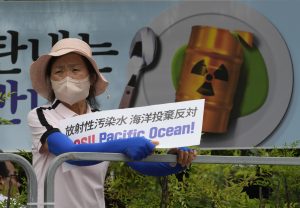At the crippled Fukushima nuclear power plant, final preparations are underway to release over a million tonnes of treated radioactive wastewater into the Pacific Ocean. The plant’s operator, Tokyo Electric Power Company (TEPCO), says it has completed the facility needed to dilute wastewater containing radioactive tritium with seawater. The construction includes a 1-kilometer undersea tunnel for discharging wastewater into the ocean.
The Japanese government is treading carefully and will set a final release date after the International Atomic Energy Agency (IAEA) releases its final report on the safety of discharge procedures.
Tritium, a radioactive isotope of hydrogen, cannot be removed by TEPCO’s Advanced Liquid Processing System (ALPS). TEPCO says that when the already-treated water is diluted with seawater, it will reduce the concentration of tritium to below the national standard. Japan’s nuclear watchdog says treated water after dilution is harmless to people and marine life. But the planned release continues to divide the international community and local businesses in Fukushima.
The looming discharge date is also stoking fears in Fukushima’s local fishing industry. Since 2011, the industry has struggled to bounce back from global seafood import bans and rumors concerning the safety of Fukushima’s produce and seafood. Local municipalities have invested large sums of money in repairing the Fukushima brand internationally and helping local farmers and fisheries get back on their feet.
The Fukushima Prefectural Fisheries Federation condemned the discharge and called on the government to store the water in tanks on land. They said it was “a matter of life and death” for the fishing industry. They argue it’s the government’s responsibility to “prevent the spread of false rumors” on the safety of Fukushima seafood.
Meanwhile, the head of the Komeito Party, the government’s junior coalition party, also advocated against the release during the summer. Yamaguchi Natsuo made a speech in Fukushima warning people not to go swimming over the risks posed to human health.
The Japanese government is also struggling to convince China and the South Korean public that its plan is safe.
China is vehemently against Japan’s discharge plan. A Foreign Ministry spokesperson said that the “Pacific Ocean is not a sewer for Japan to offload contaminated water.” China continues to suspend all food imports from Fukushima, Tokyo, and two other prefectures.
Concerns also loom large in South Korea, despite a recent streak of positive diplomatic progress. Seoul is reluctant to remove seafood import restrictions on Fukushima and eight other prefectures “unless its safety can be proved.” The discharge announcement has triggered a rush for salt, fish and other foods as South Korean consumers worry about radioactive contamination. The South Korean government has denied reports of salt hoarding.
The Japanese government hopes the IAEA’s safety assessment will help facilitate “scientific-based dialogue” to ease concerns about the plans.
IAEA Director Rafael Grossi and a team of experts will conduct a facility inspection this week. The agency is expected to hand over details of its comprehensive safety evaluation. Grossi is then scheduled to visit South Korea, New Zealand, and the Cook Islands to discuss with local authorities the outcome of the IAEA’s safety assessment to “gain mutual understanding.”
Last week Japan’s Nuclear Regulation Authority endorsed the TEPCO wastewater plans and conducted a final performance inspection. The four-member inspection team spent two weeks clearing safety checks.
Water used to cool molten nuclear fuel is building up in storage tanks on the premises of the Fukushima Daiichi Nuclear Power Plant. But the grounds only have room for 1,000 tanks, and storage is expected to reach capacity in the coming months. Plus, space currently being used for the storage tanks is needed to complete the crippled Fukushima Daiichi’s decommissioning. It’s estimated to be completed between 2041 and 2051.
In 2011 Japan experienced the strongest earthquake in its recorded history which triggered a massive tsunami on the east coast of Japan and one of the world’s worst nuclear disasters. More than ten years have passed but the country struggles to navigate decommissioning the crippled power plant and moving forward with revitalizing the prefecture and local industry devastated by the nuclear accident.
































